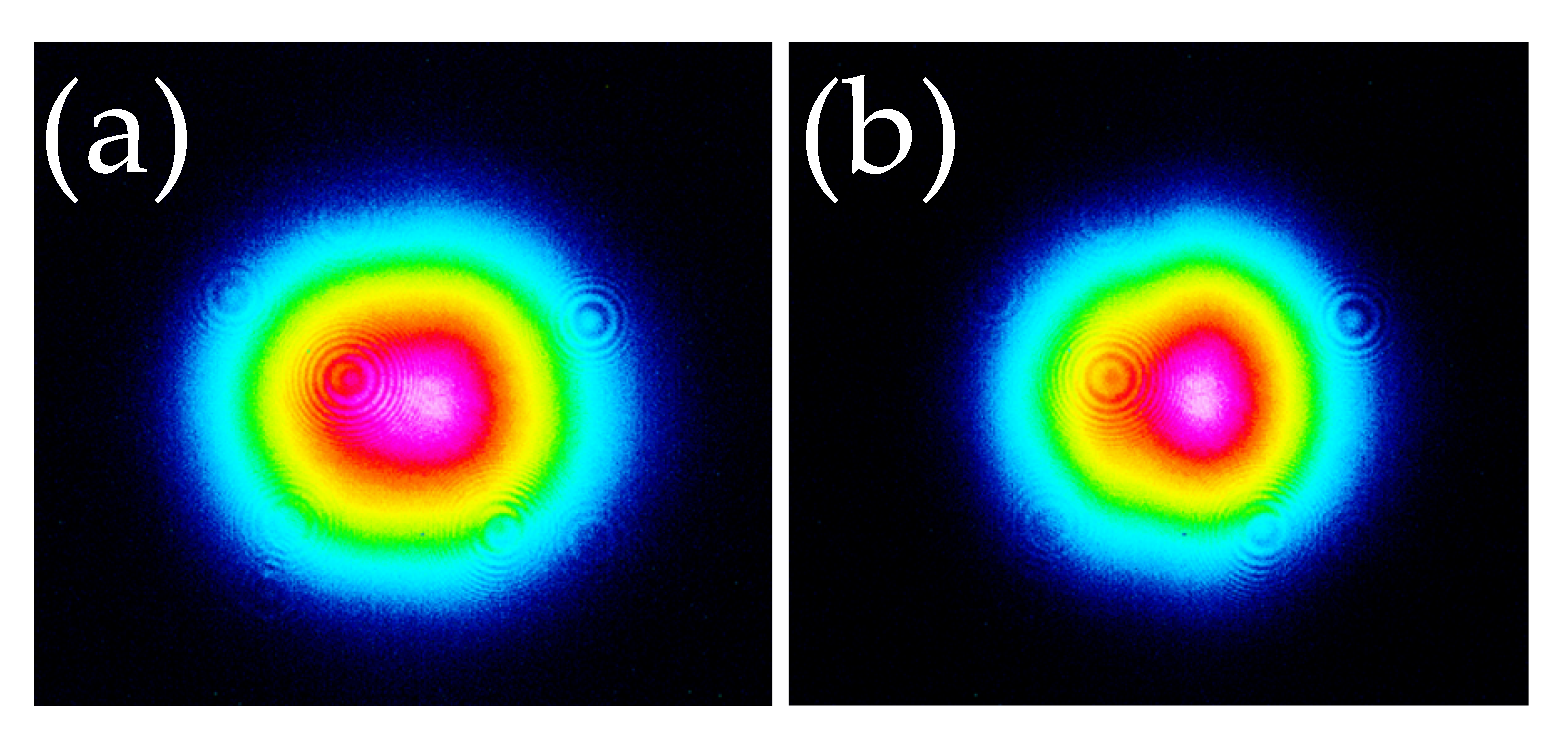Kerr-Lens Mode-Locked Yb:BaF2 Laser
Abstract
:1. Introduction
2. Experimental Setup
3. Kerr-Lens Mode-Locked Operation
4. Conclusions
Author Contributions
Funding
Institutional Review Board Statement
Informed Consent Statement
Data Availability Statement
Conflicts of Interest
References
- Siebold, M.; Bock, S.; Schramm, U.; Xu, B.; Doualan, J.L.; Camy, P.; Moncorgé, R. Yb:CaF2—A new old laser crystal. Appl. Phys. B 2009, 97, 327–338. [Google Scholar] [CrossRef]
- Siebold, M.; Hein, J.; Kaluza, M.C.; Uecker, R. High-peak-power tunable laser operation of Yb:SrF2. Opt. Lett. 2007, 32, 1818–1820. [Google Scholar] [CrossRef] [PubMed]
- Hu, C.; Xu, C.; Zhang, L.; Zhang, Q.; Zhu, R.Y. Development of yttrium-doped BaF2 crystals for future HEP experiments. IEEE Trans. Nucl. Sci. 2019, 66, 1854–1860. [Google Scholar] [CrossRef]
- Doualan, J.L.; Camy, P.; Benayad, A.; Ménard, V.; Moncorgé, R.; Boudeile, J.; Druon, F.; Balembois, F.; Georges, P. Yb3+ doped (Ca,Sr,Ba)F2 for high power laser applications. Laser Phys. 2010, 20, 533–536. [Google Scholar] [CrossRef]
- Camy, P.; Doualan, J.L.; Benayad, A.; Von Edlinger, M.; Ménard, V.; Moncorgé, R. Comparative spectroscopic and laser properties of Yb3+-doped CaF2, SrF2 and BaF2 single crystals. Appl. Phys. B 2007, 89, 539–542. [Google Scholar] [CrossRef]
- Druon, F.; Ricaud, S.; Papadopoulos, D.N.; Pellegrina, A.; Camy, P.; Doualan, J.L.; Moncorgé, R.; Courjaud, A.; Mottay, E.; Georges, P. On Yb:CaF2 and Yb:SrF2: Review of spectroscopic and thermal properties and their impact on femtosecond and high power laser performance. Opt. Mater. Express 2011, 1, 489–502. [Google Scholar] [CrossRef]
- Kato, T.; Okada, G.; Fukuda, K.; Yanagida, T. Development of BaF2 transparent ceramics and evaluation of the scintillation properties. Radiat. Meas. 2017, 106, 140–145. [Google Scholar] [CrossRef]
- Petit, V.; Camy, P.; Doualan, J.L.; Portier, X.; Moncorgé, R. Spectroscopy of Yb3+:CaF2: From isolated centers to clusters. Phys. Rev. B 2008, 78, 085131. [Google Scholar] [CrossRef]
- Lacroix, B.; Genevois, C.; Doualan, J.; Brasse, G.; Braud, A.; Ruterana, P.; Camy, P.; Talbot, E.; Moncorgé, R.; Margerie, J. Direct imaging of rare-earth ion clusters in Yb:CaF2. Phys. Rev. B 2014, 90, 125124. [Google Scholar] [CrossRef]
- Friebel, F.; Druon, F.; Boudeile, J.; Papadopoulos, D.N.; Hanna, M.; Georges, P.; Camy, P.; Doualan, J.L.; Benayad, A.; Moncorge, R.; et al. Diode-pumped 99 fs Yb:CaF2 oscillator. Opt. Lett. 2009, 34, 1474–1476. [Google Scholar] [CrossRef]
- Kowalczyk, M.; Major, A.; Sotor, J. High peak power ultrafast Yb:CaF2 oscillator pumped by a single-mode fiber-coupled laser diode. Opt. Express 2017, 25, 26289–26295. [Google Scholar] [CrossRef] [PubMed]
- Ensley, T.R.; Bambha, N.K. Ultrafast nonlinear refraction measurements of infrared transmitting materials in the mid-wave infrared. Opt. Express 2019, 27, 37940–37951. [Google Scholar] [CrossRef] [PubMed]
- Guo, Y.; Lu, S.; Su, L.; Zhao, C.; Zhang, H.; Wen, S. Z-scan measurement of the nonlinear refractive index of Nd3+, Y3+-codoped CaF2 and SrF2 crystals. Appl. Opt. 2015, 54, 953–958. [Google Scholar] [CrossRef] [PubMed]
- Machinet, G.; Sevillano, P.; Guichard, F.; Dubrasquet, R.; Camy, P.; Doualan, J.L.; Moncorgé, R.; Georges, P.; Druon, F.; Descamps, D.; et al. High-brightness fiber laser-pumped 68 fs-2.3 W Kerr-lens mode-locked Yb:CaF2 oscillator. Opt. Lett. 2013, 38, 4008–4010. [Google Scholar] [CrossRef] [PubMed]
- Sevillano, P.; Machinet, G.; Dubrasquet, R.; Camy, P.; Doualan, J.L.; Moncorge, R.; Georges, P.; Druon, F.P.; Descamps, D.; Cormier, E.E.D.H.G.; et al. Sub-50 fs, Kerr-lens mode-locked Yb:CaF2 laser oscillator delivering up to 2.7 W. In Advanced Solid-State Lasers Congress; Optical Society of America: Paris, France, 2013; p. AF3A.6. [Google Scholar]
- Su, X.; Wang, Y.; Li, G.; Su, L.; Liu, S.; Zheng, L.; Zhang, B.; Zhang, B. Sub-60-fs ultralow threshold and efficient Kerr-lens mode-locked Yb,Gd:CaSrF2 laser. Opt. Lett. 2022, 47, 2362–2365. [Google Scholar] [CrossRef] [PubMed]
- Su, X.; Wang, Y.; Su, L.; Liu, S.; Zheng, L.; Zhang, B.; He, J.; Zhang, B. Sub-50-fs Kerr-lens mode-locked Yb-doped fluoride laser with 44% optical efficiency. Appl. Opt. 2024, 63, 912–916. [Google Scholar] [CrossRef]
- Normani, S.; Loiko, P.; Basyrova, L.; Benayad, A.; Braud, A.; Dunina, E.; Fomicheva, L.; Kornienko, A.; Hideur, A.; Camy, P. Mid-infrared emission properties of erbium-doped fluorite-type crystals. Opt. Mater. Express 2023, 13, 1836–1851. [Google Scholar] [CrossRef]
- Xue, W.Z.; Lin, Z.L.; Zeng, H.J.; Zhang, G.; Loiko, P.; Basyrova, L.; Benayad, A.; Camy, P.; Petrov, V.; Mateos, X.; et al. Diode-pumped mode-locked Yb:BaF2 laser. Opt. Express 2022, 30, 15807–15818. [Google Scholar] [CrossRef] [PubMed]





Disclaimer/Publisher’s Note: The statements, opinions and data contained in all publications are solely those of the individual author(s) and contributor(s) and not of MDPI and/or the editor(s). MDPI and/or the editor(s) disclaim responsibility for any injury to people or property resulting from any ideas, methods, instructions or products referred to in the content. |
© 2024 by the authors. Licensee MDPI, Basel, Switzerland. This article is an open access article distributed under the terms and conditions of the Creative Commons Attribution (CC BY) license (https://creativecommons.org/licenses/by/4.0/).
Share and Cite
Li, Z.-Q.; Lin, Z.-L.; Loiko, P.; Zeng, H.-J.; Zhang, G.; Nie, H.-Y.; Normani, S.; Benayad, A.; Camy, P.; Mateos, X.; et al. Kerr-Lens Mode-Locked Yb:BaF2 Laser. Photonics 2024, 11, 322. https://doi.org/10.3390/photonics11040322
Li Z-Q, Lin Z-L, Loiko P, Zeng H-J, Zhang G, Nie H-Y, Normani S, Benayad A, Camy P, Mateos X, et al. Kerr-Lens Mode-Locked Yb:BaF2 Laser. Photonics. 2024; 11(4):322. https://doi.org/10.3390/photonics11040322
Chicago/Turabian StyleLi, Zhi-Qiang, Zhang-Lang Lin, Pavel Loiko, Huang-Jun Zeng, Ge Zhang, Hai-Yu Nie, Simone Normani, Abdelmjid Benayad, Patrice Camy, Xavier Mateos, and et al. 2024. "Kerr-Lens Mode-Locked Yb:BaF2 Laser" Photonics 11, no. 4: 322. https://doi.org/10.3390/photonics11040322




